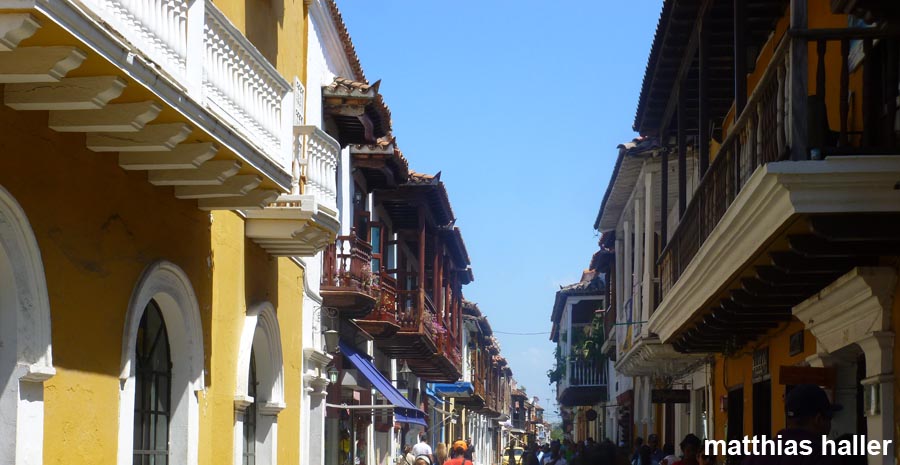
Old town of Cartagena
The old town of Cartagena has been a UNESCO World Heritage Site since 1984 and is the most famous attraction of Cartagena de Indias. Cartagena was founded by Petro de Heredia in 1533, making it one of the first cities to be founded on the South American continent by the Spanish conquerors. The old town of Cartagena is completely enclosed by a city wall and impresses with piroresque houses from the colonial era. The neighboring districts of San Diego and Getsemani are also part of the world heritage. The Spaniards later developed a right-angled grid to built new cities in America. Cartagena has not yet used this pattern, the streets run all at a different angle to each other. As a result, no two blocks are the same and the historic center looks like a grown city.
The Cathedral of Cartagena, which was built between 1577 and 1612, is also part of the UNESCO World Heritage. The cathedral was built in the Herrera style, a strict late Renaissance architectural style developed by the Spanish architect Juan de Herrera. In the three-aisled basilica, the wooden roof structure can be seen, which in most other churches is covered by cladding.
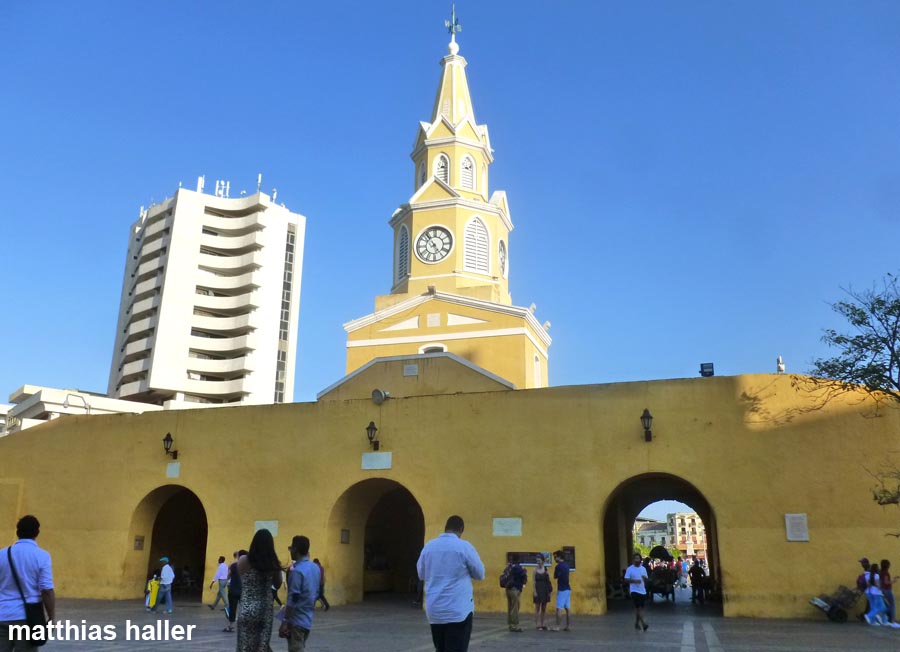
Torre del Reloj
The Torre del Reloj (clock tower) is located at the Puerta del Reloj, the main entrance to the historic old town of Cartagena. At the time of Nueva Granada, there was a moat in front of the gate, over which a drawbridge led into the city. The locals call the gate "Boca del Puente" (mouth of the bridge). The entrance was rebuilt in 1704 after the city had previously been pillaged by pirates several times. The Puerta del Reloj has two different facades. From the outside, the gate is made of natural stone and has a raised, baroque arch over the central passage, behind which the yellow clock tower rises. From inside the city wall you can see a plastered facade with yellow paint and three openings (photo). The soaring clock tower was erected in 1874. The Torre del Reloj is a landmark of Cartagena.
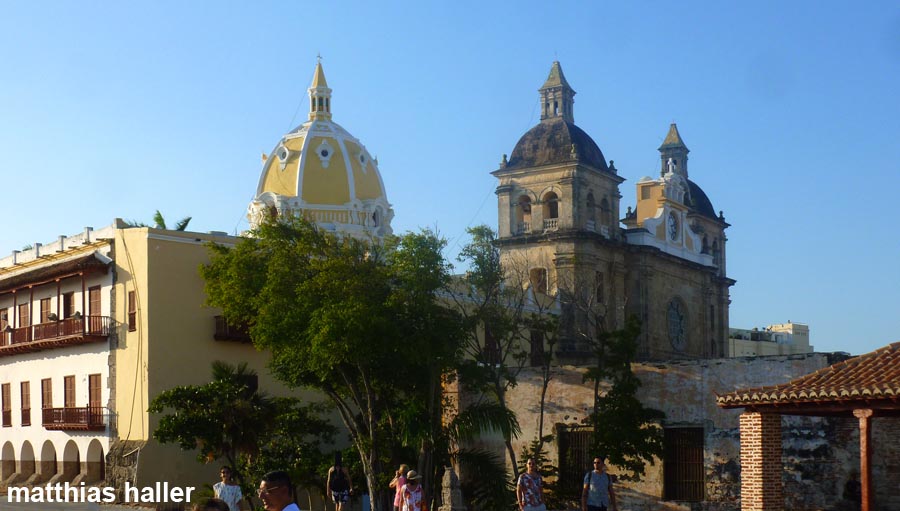
San Petro Claver
The Church of San Petro Claver is dedicated to the missionary Petro Claver (1580-1654) who sailed from Catalonia to America to convert slaves from Africa. In the 40 years that he worked in Nueva Granada, he is said to have Christianized around 300,000 slaves. At that time, the viceroyalty of New Granada extended over today's countries Colombia, Venezuela, Ecuador and Panama. Petro Claver died in Cartagena and was buried in this church, which was later named after him. His bones lie in a glass case under the altar. Petro Claver was canonized in 1888.
The church was built between 1580 and 1654 as the Church of San Juan de Dios in the Spanish colonial style. The yellow dome was built in 1921. The lush garden in the cloister courtyard is also worth seeing.
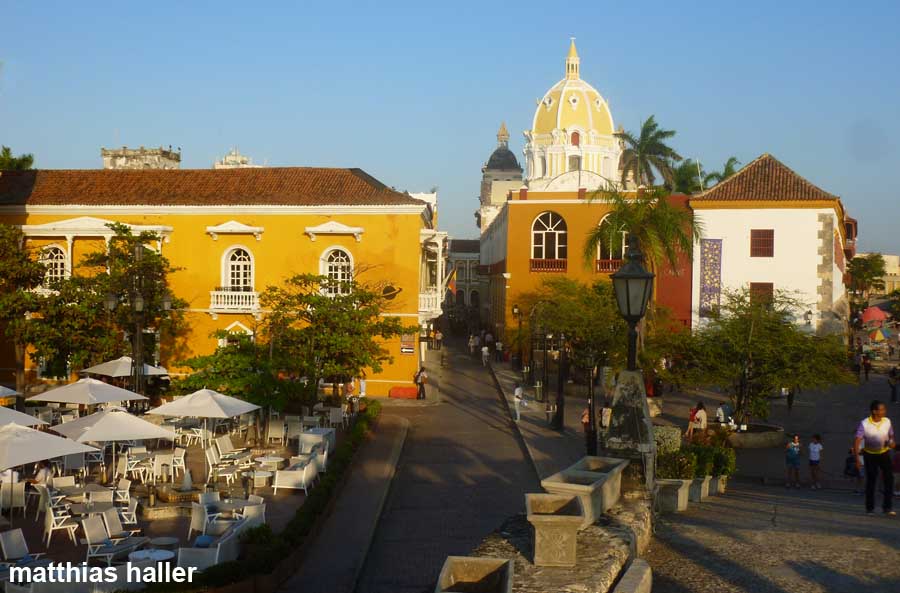
Plaza de Santa Teresa
One of the most beautiful places in the center is the Plaza de Santa Teresa. The square is located at the southwest end of the old town. From here you can climb the ramp onto the city wall and see on one side the Caribbean Sea and the skyline of the hotel towers of Bocagrande. And on the other side you can see the old town of Cartagena. There are trees at the Plaza de Santa Teresa and there is a passage to the sea, so a cool breeze often blows here in the evening and makes staying on the square very pleasant. The grill restaurant on the city wall is also very popular. In the background you can see the dome of the Church of San Petro Claver.
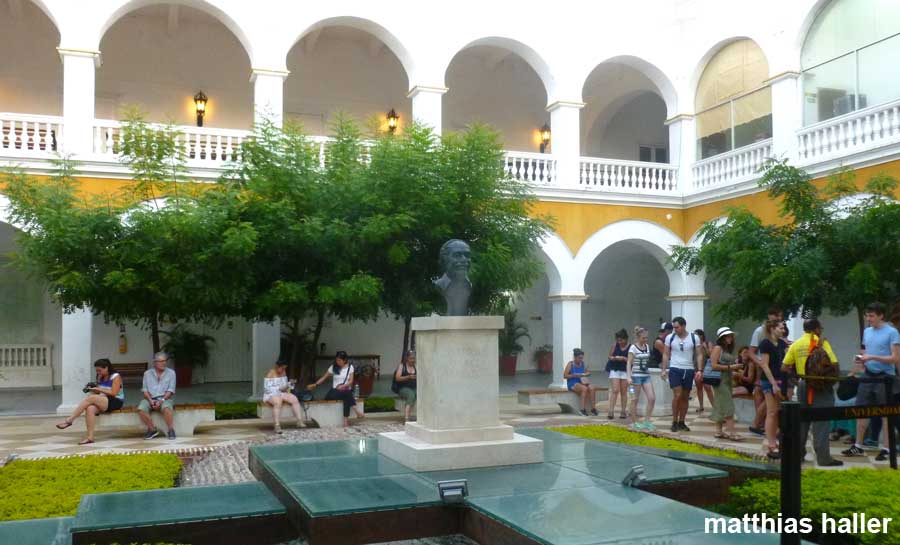
Garcia Marquez Monument
Gabriel Garcia Marquez (1927-2014) was a Colombian writer who received the Nobel Prize for Literature in 1982. Marquez was born in Aracataca, a small town around 150 kilometers east of Cartagena. He studied law in Bogota and lived in Mexico City for the last years until his death. Some of his ashes were brought to Cartagena de Indias, where a monument to Garcia Marquez was erected in the Claustro de la Merced. Marquez is one of the most famous personalities in Colombia. The lovely inner courtyard is located north of the Teatro Heredia.
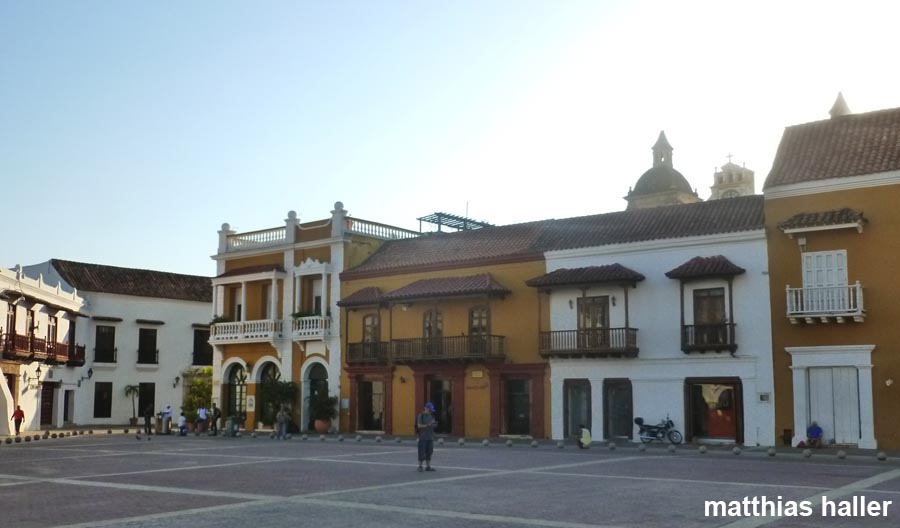
Plaza de la Aduana
The Plaza de la Aduana (Customs Square) is located between the Puerta del Reloj and the Church of San Petro Claver. There are no trees on the large triangular square and there are also relatively few cafes or restaurants. In colonial times, the largest slave market of South America took place here. Today the Alcaldia Mayor de Cartagena de Indias (City Hall of Cartagena) is the most striking building at the square. The long, white building with arcades on the ground floor looks like a warehouse. And there are beautiful colonial houses on the square with typical wooden balconies. The Plaza de la Aduana is Cartagena's fairground, this is where the anual celebration of Colombia's independence takes place. In the square there is a monument to the city's heroes.
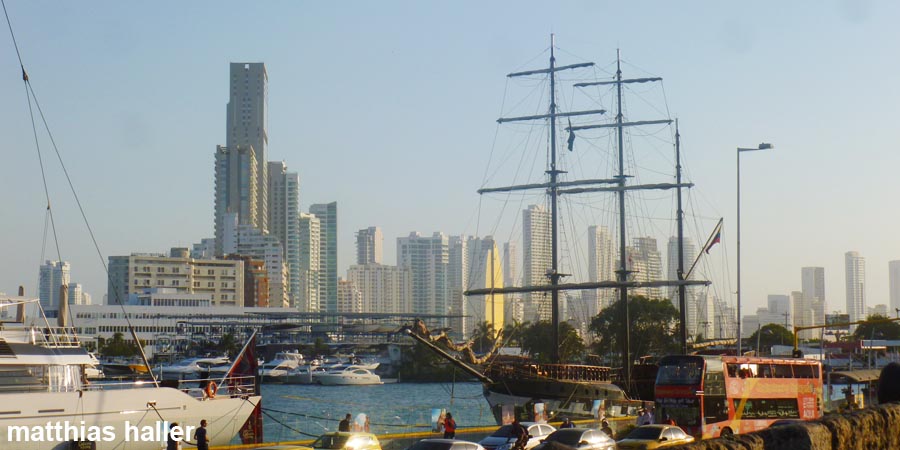
The port of Cartagena
Cartagena de Indias was founded as a port city by the Spanish to conquer the north of South America. Soldiers and cannons came ashore to seize gold and silver for Spain. Cartagena was the most important naval base of the Spaniards on the continent. This is where the stolen treasures were stored until they were picked up by the galleons. The slave ships from Africa also came to the port of Cartagena because the local population was not suitable for the hard work in the sugar cane fields and was greatly reduced by European epidemics. The old harbor basin is located near the Puerta del Reloj, directly behind the city wall.
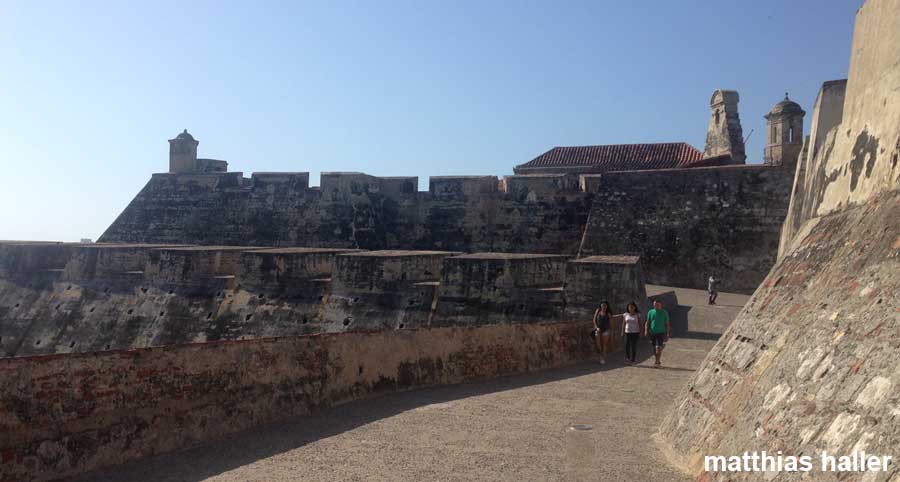
Castillo San Felipe
The Castillo San Felipe de Barajas was built starting in 1536 on the hill of San Lazaro. From here you can protect the access to the port of Cartagena and repel an attack from the land side. The fortress of Cartagena was named after the Spanish King Felipe IV. The Castillo San Felipe was expanded in 1658. Cartagena was sacked by French pirates in 1697. Between 1740 and 1741 the British tried to conquer Cartagena 3 times, but failed at the Castillo San Felipe and its experienced admiral Blas de Lezo. After the British attacks, the fortress was reinforced by Antonio de Arévalo in 1763. With 200 soldiers and 68 cannons, the fortress on the 42 m high hill could hardly be overcome.
The Castillo San Felipe de Barajas is well preserved and the best example of fortress architecture of the Spanish colonial era. For this reason, it was declared a UNESCO World Heritage Site together with the old town of Cartagena. For tourists, the visit is also worthwhile because of the beautiful view of the city and the harbor.
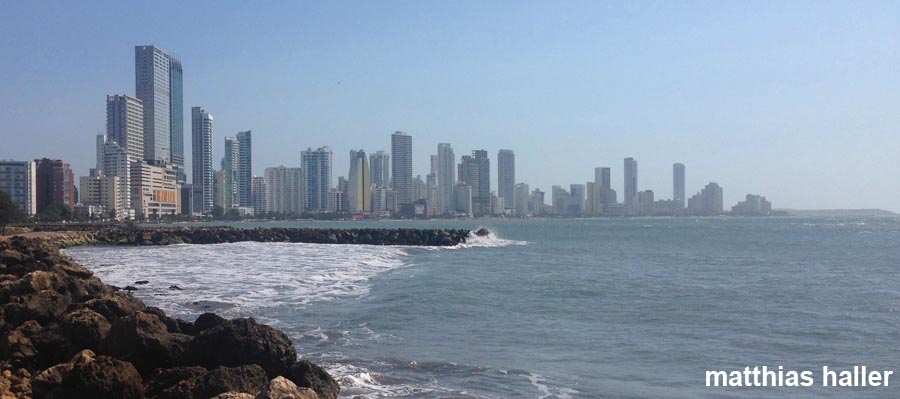
The beaches of Cartagena
The beaches of Cartagena are on the headlands north and south of the old town. Hotel skyscrapers stand on the wide sandy beaches and form an impressive skyline. The best known beach is the Playa de Bocagrande in the south of the city (photo). The beach in the north of Cartagena is called Playa Marbella. Both beaches can be reached within 15 minutes on foot from the historic center.
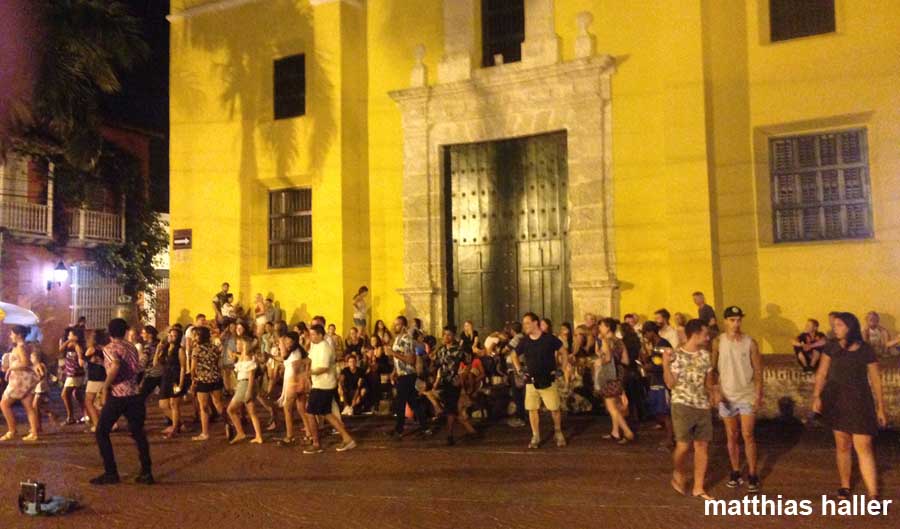
Plaza de la Trinidad
The Plaza de la Trinidad is the center of Gethsemani. This district is located between the old town and the Castillo San Felipe. The name of the neighborhood refers to the Garden of Gethsemane in Jerusalem. The Getsemani district is just as beautiful as the old town, the small houses are brightly painted and cafes and restaurants attract many visitors. Especially in the evening it gets crowded on the square in front of the Iglesia de la Trinidad. Street musicians and dancers make all the clichés of a Caribbean night come true.
Tourist Map of Cartagena
ads
City Guide Cartagena
ads
ads


